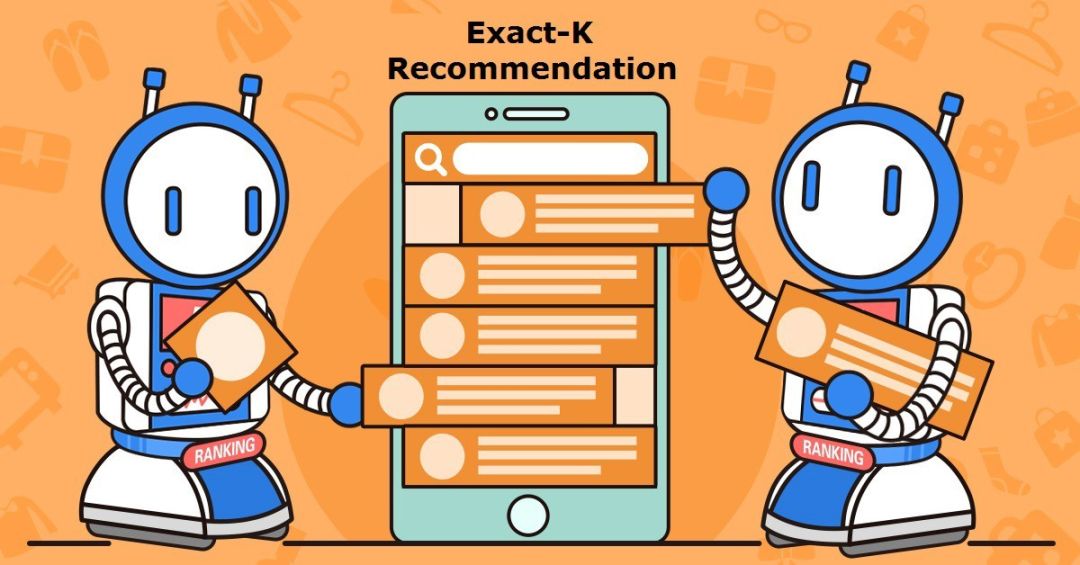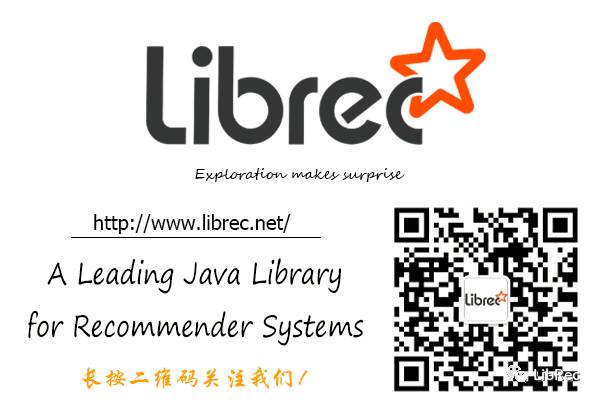LibRec 精选:Facebook 推荐算法 DLRM,阿里巴巴 Exact-k 推荐
LibRec 精选
【PPT】交互式推荐系统,Interactive recommender systems and dashboards for learning,链接:https://www.slideshare.net/kverbert/interactive-recommender-systems-and-dashboards-for-learning
【教程】利用机器学习库(scikit-learn)构建推荐系统,链接:https://morioh.com/p/37bd04e2d592/machine-learning-building-recommender-systems
【博客】推荐系统的两个常用评估指标(Precision、Recall)及其解释。链接:https://medium.com/qloo/popular-evaluation-metrics-in-recommender-systems-explained-324ff2fb427d
【开源算法】Facebook 推荐模型 DLRM,博客链接:
https://ai.facebook.com/blog/dlrm-an-advanced-open-source-deep-learning-recommendation-model
源码链接:https://github.com/facebookresearch/dlrm
【小项目】利用SVM来预测酒店客户的取消预定,链接:https://www.michael-grogan.com/hotel-cancellations/
【小项目】Google Map利用实时交通数据预测公交汽车的延迟,链接:https://ai.googleblog.com/2019/06/predicting-bus-delays-with-machine.html
【工程经验】阿里巴巴提出Exact-K推荐,Finding the Right Clique: Alibaba Advances Exact-K Recommendation,链接:https://medium.com/@alitech_2017/finding-the-right-clique-alibaba-advances-exact-k-recommendation-a3e88d23c297
论文:Exact-K Recommendation via Maximal Clique Optimization
【开源项目】
1. TorchKGE:a PyTorch-based library for knowledge graph embedding,链接:https://github.com/torchkge-team/torchkge
2. PyTorch-Transformers:an open-source library of pretrained NLP transformer models,包括 Google's BERT、OpenAI's GPT & GPT-2、Google/CMU's Transformer-XL & XLNet 和 Facebook's XLM,
链接:https://github.com/huggingface/pytorch-transformers
3. 【视频教程】基于PyTorch的神经网络编程,链接:https://deeplizard.com/learn/playlist/PLZbbT5o_s2xrfNyHZsM6ufI0iZENK9xgG,Youtube链接:https://www.youtube.com/watch?v=v5cngxo4mIg&list=PLZbbT5o_s2xrfNyHZsM6ufI0iZENK9xgG
近期热点论文
导读:随着越来越多的深度学习模型应用于推荐系统,学者们也在开始反思,深度学习真的适合推荐场景吗?它们的性能真的要远超过KNN这样的基线模型吗?本期第 7 篇论文给出了这样的一个思考和验证。
1. An Item Recommendation Approach by Fusing Images based on Neural Networks
Weibin Lin, Lin Li
https://arxiv.org/abs/1907.02203
There are rich formats of information in the network, such as rating, text, image, and so on, which represent different aspects of user preferences. In the field of recommendation, how to use those data effectively has become a difficult subject. However, the characteristics of the item may affect the user's preferences, which are rarely used for recommendation models. In this work, we propose a novel model to incorporate visual factors into predictors of people's preferences, namely MF-VMLP, based on the recent developments of neural collaborative filtering (NCF). To some extent, experimental result on a real-world data set demonstrates that our model can boost the recommendation performance.
2. Graph Embeddings at Scale
C. Bayan Bruss, Anish Khazane, Jonathan Rider, Richard Serpe, Saurabh Nagrecha, Keegan E. Hines
https://arxiv.org/abs/1907.01705
Graph embedding is a popular algorithmic approach for creating vector representations for individual vertices in networks. Training these algorithms at scale is important for creating embeddings that can be used for classification, ranking, recommendation and other common applications in industry. In this paper, we propose a distributed infrastructure that completely avoids graph partitioning, dynamically creates size constrained computational graphs across worker nodes, and uses highly efficient indexing operations for updating embeddings that allow the system to function at scale. We show that our system can scale an existing embeddings algorithm - skip-gram - to train on the open-source Friendster network (68 million vertices) and on an internal heterogeneous graph (50 million vertices). We conclude this work by analyzing how a greater number of worker nodes actually improves our system's performance on the aforementioned metrics and discuss our next steps for rigorously evaluating the embedding vectors produced by our system.
3. Bandit Learning for Diversified Interactive Recommendation
Yong Liu, Yingtai Xiao, Qiong Wu, Chunyan Miao, Juyong Zhang
https://arxiv.org/abs/1907.01647
Interactive recommender systems that enable the interactions between users and the recommender system have attracted increasing research attentions. Previous methods mainly focus on optimizing recommendation accuracy. In this paper, we propose a novel diversified recommendation model, named Diversified Contextual Combinatorial Bandit (DC2B), for interactive recommendation with users' implicit feedback. Specifically, DC2B employs determinantal point process in the recommendation procedure to promote diversity of the recommendation results. Extensive experiments on real datasets are performed to demonstrate the effectiveness of the proposed method.
4. Combating the Filter Bubble: Designing for Serendipity in a University Course Recommendation System
Zachary A. Pardos, Weijie Jiang
https://arxiv.org/abs/1907.01591
Collaborative filtering based algorithms, including Recurrent Neural Networks (RNN), tend towards predicting a perpetuation of past observed behavior. In this paper, we grapple with the issue of the filter bubble in the context of a course recommendation system in production at a public university. We introduce a novel modification to the skip-gram model applied to nine years of historic course enrollment sequences to learn course vector representations used to diversify recommendations based on similarity to a student's specified favorite course. We compare the performance of these models to the system's existing RNN-based recommendations with a user study of undergraduates (N = 70) rating six characteristics of their course recommendations. Results of the user study show a dramatic lack of novelty in RNN recommendations and depict the characteristic trade-offs that make serendipity difficult to achieve.
5. On the Importance of News Content Representation in Hybrid Neural Session-based Recommender Systems
Gabriel de Souza P. Moreira, Dietmar Jannach, Adilson Marques da Cunha
https://arxiv.org/abs/1907.07629
News recommender systems are designed to surface relevant information for online readers by personalizing their user experiences. A particular problem in that context is that online readers are often anonymous, which means that this personalization can only be based on the last few recorded interactions with the user, a setting named session-based recommendation. Another particularity of the news domain is that constantly fresh articles are published, which might be immediately considered for recommendation. To deal with such item cold-start problem, it is important to consider the actual content of items when recommending. Hybrid approaches are therefore often considered as the method of choice in such settings. In this work, we analyze the importance of considering content information in a hybrid neural news recommender system. We contrast content-aware and content-agnostic techniques and also explore the effects of using different content encodings. Experiments on two public datasets confirm the importance of adopting a hybrid approach. Furthermore, the choice of the content encoding can have an impact on the resulting performance.
6. Decentralized & Collaborative AI on Blockchain
Justin D. Harris, Bo Waggoner
https://arxiv.org/abs/1907.07247
Machine learning has recently enabled large advances in artificial intelligence, but these tend to be highly centralized. The large datasets required are generally proprietary; predictions are often sold on a per-query basis; and published models can quickly become out of date without effort to acquire more data and re-train them. We propose a framework for participants to collaboratively build a dataset and use smart contracts to host a continuously updated model. This model will be shared publicly on a blockchain where it can be free to use for inference. Ideal learning problems include scenarios where a model is used many times for similar input such as personal assistants, playing games, recommender systems, etc. In order to maintain the model's accuracy with respect to some test set we propose both financial and non-financial (gamified) incentive structures for providing good data. A free and open source implementation for the Ethereum blockchain is provided at https://github.com/microsoft/0xDeCA10B.
7. Are We Really Making Much Progress? A Worrying Analysis of Recent Neural Recommendation Approaches
Maurizio Ferrari Dacrema, Paolo Cremonesi, Dietmar Jannach
https://arxiv.org/abs/1907.06902
Deep learning techniques have become the method of choice for researchers working on algorithmic aspects of recommender systems. With the strongly increased interest in machine learning in general, it has, as a result, become difficult to keep track of what represents the state-of-the-art at the moment, e.g., for top-n recommendation tasks. At the same time, several recent publications point out problems in today's research practice in applied machine learning, e.g., in terms of the reproducibility of the results or the choice of the baselines when proposing new models. In this work, we report the results of a systematic analysis of algorithmic proposals for top-n recommendation tasks. Specifically, we considered 18 algorithms that were presented at top-level research conferences in the last years. Only 7 of them could be reproduced with reasonable effort. For these methods, it however turned out that 6 of them can often be outperformed with comparably simple heuristic methods, e.g., based on nearest-neighbor or graph-based techniques. The remaining one clearly outperformed the baselines but did not consistently outperform a well-tuned non-neural linear ranking method. Overall, our work sheds light on a number of potential problems in today's machine learning scholarship and calls for improved scientific practices in this area. Source code of our experiments and full results are available at: https://github.com/MaurizioFD/RecSys2019_DeepLearning_Evaluation.
8. Deep Social Collaborative Filtering
Wenqi Fan, Yao Ma, Dawei Yin, Jianping Wang, Jiliang Tang, Qing Li
https://arxiv.org/abs/1907.06853
Recommender systems are crucial to alleviate the information overload problem in online worlds. Most of the modern recommender systems capture users' preference towards items via their interactions based on collaborative filtering techniques. In addition to the user-item interactions, social networks can also provide useful information to understand users' preference as suggested by the social theories such as homophily and influence. Recently, deep neural networks have been utilized for social recommendations, which facilitate both the user-item interactions and the social network information. However, most of these models cannot take full advantage of the social network information. They only use information from direct neighbors, but distant neighbors can also provide helpful information. Meanwhile, most of these models treat neighbors' information equally without considering the specific recommendations. However, for a specific recommendation case, the information relevant to the specific item would be helpful. Besides, most of these models do not explicitly capture the neighbor's opinions to items for social recommendations, while different opinions could affect the user differently. In this paper, to address the aforementioned challenges, we propose DSCF, a Deep Social Collaborative Filtering framework, which can exploit the social relations with various aspects for recommender systems. Comprehensive experiments on two-real world datasets show the effectiveness of the proposed framework.
9. Towards QoS-Aware Recommendations
Pavlos Sermpezis, Savvas Kastanakis, João Ismael Pinheiro, Felipe Assis, Daniel Menasché, Thrasyvoulos Spyropoulos
https://arxiv.org/abs/1907.06392
This paper suggests the concept of QoS-aware recommendations for multimedia services/applications. We propose that recommendation systems (RSs) should take into account the expected QoS with which a content can be delivered to a user, to increase the user satisfaction and retention rates. While QoS-aware (or, network-aware) recommendations have been recently proposed as a promising solution to improve network performance, the impact of this idea on real user experience has only been speculated. Our contributions in this direction are the following: (i) we reconsider the problem from the perspective of users and the RS; (ii) to support our suggestions, we conduct experiments with real users, and present initial experimental results. Our analysis demonstrates the potential of the idea: QoS-aware recommendations could be beneficial for both the users (better experience) and content providers (higher retention rates). We believe that our study can help open a future research direction.
10. A Novel User Representation Paradigm for Making Personalized Candidate Retrieval
Zheng Liu, Yu Xing, Jianxun Lian, Defu Lian, Ziyao Li, Xing Xie
https://arxiv.org/abs/1907.06323
Candidate retrieval is a crucial part in recommendation system, where quality candidates need to be selected in realtime for user's recommendation request. Conventional methods would make use of feature similarity directly for highly scalable retrieval, yet their retrieval quality can be limited due to inferior user interest modeling. In contrast, deep learning-based recommenders are precise in modeling user interest, but they are difficult to be scaled for efficient candidate retrieval. In this work, a novel paradigm Synthonet is proposed for both precise and scalable candidate retrieval. With Synthonet, user is represented as a compact vector known as retrieval key. By developing an Actor-Critic learning framework, the generation of retrieval key is optimally conducted, such that the similarity between retrieval key and item's representation will accurately reflect user's interest towards the corresponding item. Consequently, quality candidates can be acquired in realtime on top of highly efficient similarity search methods. Comprehensive empirical studies are carried out for the verification of our proposed methods, where consistent and remarkable improvements are achieved over a series of competitive baselines, including representative variations on metric learning.






